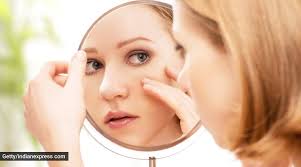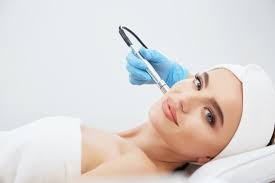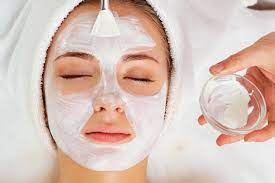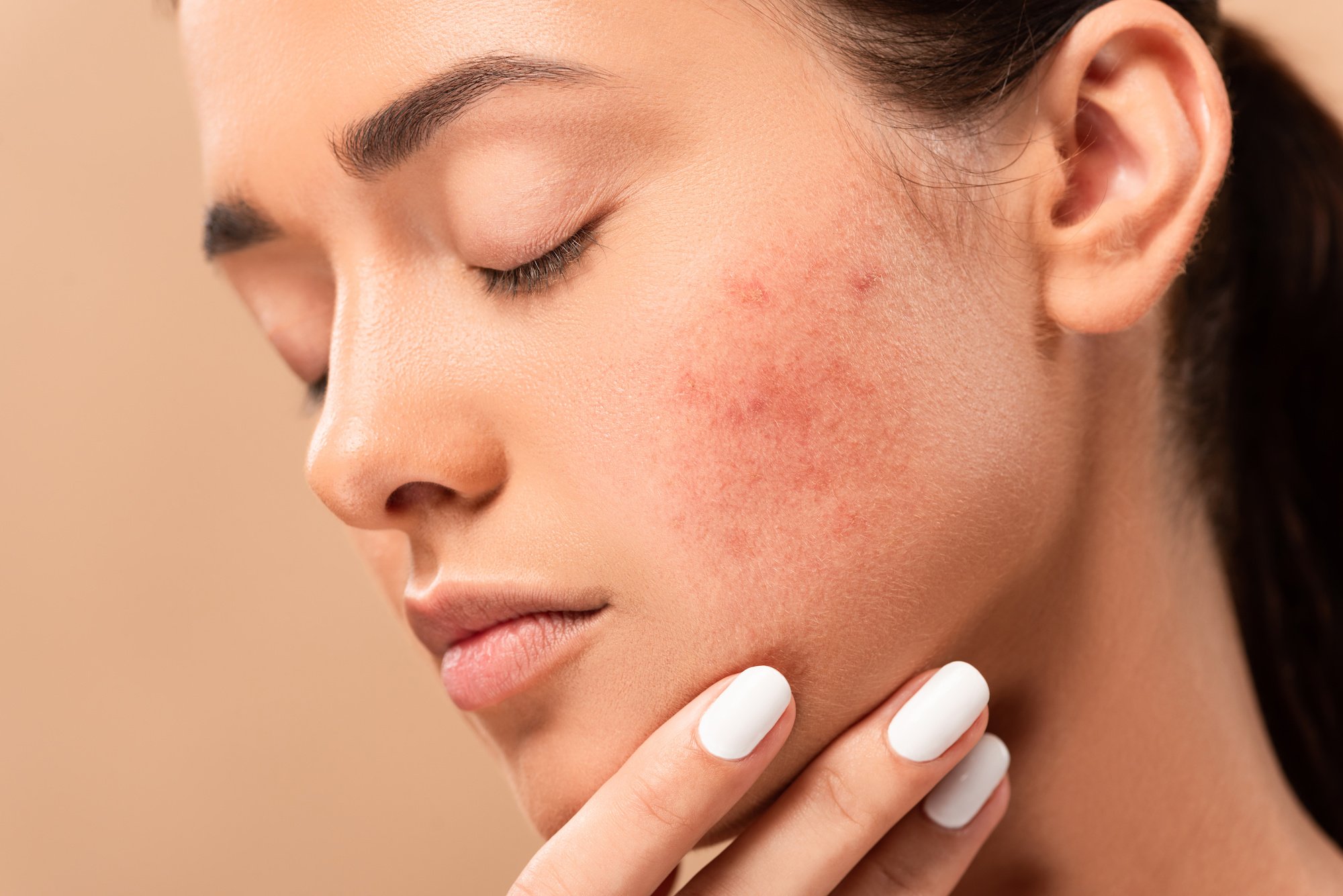Symptoms
Acne signs vary depending on the severity of your condition:
- • Whiteheads (closed plugged pores)
- • Blackheads (open plugged pores)
- • Small red, tender bumps (papules)
- • Pimples (pustules), which are papules with pus at their tips
- • Large, solid, painful lumps under the skin (nodules)
- • Painful, pus-filled lumps under the skin (cystic lesions)
Acne typically appears on your face, forehead, chest, upper back , and shoulders because these areas of skin have the most oil (sebaceous) glands.
Certain things may trigger or worsen acne:
Hormonal changes. Androgens are hormones that increase in boys and girls during puberty and cause the sebaceous glands to enlarge and make more sebum. Hormone changes during midlife, particularly like PCOD problem in women, can lead to breakouts too.
Certain medications. Examples include drugs containing corticosteroids, testosterone or lithium.
Diet. Studies indicate that consuming certain foods — including carbohydrate-rich foods, such as bread, sweets and chips — may worsen acne. Further study is needed to examine whether people with acne would benefit from following specific dietary restrictions.
Stress. Stress doesn't cause acne, but if you have acne already, stress may act as a worsening factor.
Acne mythsThese factors have little effect on acne:
Chocolate and greasy foods. Eating chocolate or greasy food has little to no effect on acne.
Hygiene. Acne isn't caused by dirty skin. In fact, scrubbing the skin too hard or cleansing with harsh soaps or chemicals irritates the skin and can make acne worse.
Cosmetics. Cosmetics don't necessarily worsen acne, especially if you use oil-free makeup that doesn't clog pores (noncomedogenics) and remove makeup regularly. Nonoily cosmetics don't interfere with the effectiveness of acne drugs.
ComplicationsPeople with darker skin types are more likely than are people with lighter skin to experience these acne complications:
Post inflammatotory hyperpigmentation or hypopigmentation. After acne has cleared, the affected area of the skin may become darker or lighter than before.
Scars Pitted skin (acne scars) and thick scars (keloids) can occur if the condition is neglected for long or patient has had a very severe grade acne.
Emotional distress Severe acne can cause lot of emotional distress reduced self confidence ,hence the treatment must be started at the earliest to prevent all the complications and scarring.
TreatmentAcne Scar Treatment in Chandigarh is usually divided into the following steps
- • Controlling your acne
- • Avoiding scarring or pigementary damage to your skin
- • Making the scars less noticeable
Acne medication Acne medications aim at reducing oil production and treating bacterial infection. With most prescription acne drugs, you may not see results immediately. It will take at least four to eight weeks to start noticing an appreciable improvement. It can take many months for your acne to clear up completely.
Topical medications and oral medication are often used in combination. Treatment options for pregnant women are limited due to the risk of side effects.
Topical treatment
The most common topical prescription medications for acne are:
- • Retinoids and retinoid-like drugs.
- • Topical Antibiotics.
- • Benzoyl peroxide
- • Azelaic acid and salicylic acid
- • Dapsone

Oral Antibiotics. Your doctor might feel the need to put you on oral antibiotics depending upon the severity of your acne. Commonly used antibiotics are Doxycycline, Minocycline, Azithromycin etc.
Combined oral contraceptives. Your doctor might start you on oral contraceptive pills if you have hormonal disturbances which might be the reason behind your acne issue.
Anti-androgen agents. The drug spironolactone (Aldactone) may be considered for women and adolescent girls if oral antibiotics aren't helping. It works by blocking the effect of androgen hormones on the oil-producing glands. s
Isotretinoin. Isotretinoin is by far the most effective drug to control severe grade acne or acne which is not responding to the usual course of medication. There are few side effects and contraindications for this drug and your dermatologist is the best person to decide the benefits verses adverse effects.
TREATMENT OF ACNE SCARS.Acne scars are stubborn, and no single treatment is best for everyone. Usually, a combination of the following approaches might improve the appearance of your skin, depending on your scar type, your skin type, and the severity of the scarring.At Dr. Naiya Bansal’s clinic , we offer the best acne scar treatments in Chandigarh through various latest treatment modalities which help to reduce or treat acne scars as mentioned below:
Microdermabrasion
Microdermabrasion is a very subtle and superficial exfoliation of the superficial epidermal layer and dead cells of the skin which is done with the help of a mechanical device. It leads to regeneration of the epidermis, declogging of the blocked pores, removal of the collected dirt, debris, and sebum from the skin surface, thereby cleansing the skin, reducing the acne formation, and also aids in penetration of topical medication, thereby giving the fresher appearance and radiant glow to the face and clearer acne-free skin for a longer duration. The procedure itself is an office procedure that hardly takes 15 to 20 minutes and can be done at a frequency of once a week or fortnight depending upon the condition.
Chemical peels
This is by far the most effective and rewarding procedure in which repeated applications of a chemical solution, such as salicylic acid, glycolic acid, or retinoic acid are applied to your skin for a particular duration followed by neutralization by your doctor. Successive sessions of these treatments improve the tone, texture pigmentary changes, and superficial acne scars to a remarkable extent. Chemical peel treatment is the most commonly done cosmetic procedure in any dermatology clinic. The procedure can be taken during office hours without any downtime or significant risk factors.
At Dr. Naiya Bansal’s skin and laser clinic, we offer the best and most result-oriented chemical peeling treatments which are customized to the need of every individual according to the medical state, skin type, complexion, and various other factors.
Our acne scar treatment in Chandigarh are one of their kind and they usually require multiple sessions at a gap of 2 to 3 weeks each leading to a gradual improvement in the appearance of the skin.
Black peels These are specialized peels specifically designed to treat active acne whereby your dermatologist might remove your comedones and apply a layer of the black peel on your skin followed by cleansing or neutralization. This process leads to a better and faster resolution of active acne.
Laser resurfacing.
Laser resurfacing is a facial rejuvenation procedure that uses a laser device to improve the appearance and texture of the skin. It can be done with:Ablative laser. This works on the principle of wound healing wherein a wounding laser is used which removes the outer thin layer of the skin (epidermis) and heats the underlying skin (dermis), which stimulates the growth of new collagen fibers. As the epidermis heals and regrows, the treated area appears much smoother and tighter. This treatment comes with downtime and requires a proper after-care skin protocol to be followed.
Types of ablative treatments include the carbon dioxide (CO2) laser, the erbium laser, and combination systems. Both the lasers can be delivered with a fractional laser system, which leaves microscopic columns of untreated tissue throughout the treatment area which helps to cause lesser damage, and faster skin healing thereby making the procedure very safe and also help to reduce the downtime to the minimum. Fractional lasers were developed to shorten recovery time and reduce the risk of side effects.
Nonablative laser. This is a simpler and less aggressive procedure where the non-wounding laser is used which stimulates collagen growth, which over some time helps improve the skin tone and texture. This approach can be done with various types of lasers as well as intense pulsed light (IPL) devices. Non-ablative laser resurfacing is less invasive and requires less recovery time than does ablative laser resurfacing. But it's less effective also. The benefits of non-ablative treatments are that these are office time procedures with little or no downtime, and also the post-procedure care of precautions are very minimal.
Laser resurfacing can significantly decrease the appearance of acne scars as well as other types of scars as caused by trauma, burn injury, or scars caused by chicken pox on the face. It can also treat loss of skin tone and improve the complexion if you have scars or sun damage. laser resurfacing does improve the tone and texture of the skin by the help of collagen remodelling which makes it a very effective tool for the treatment of acne scars as well as lines and wrinkles on the face.
It also helps combat the early signs of ageing and photodamage .Laser resurfacing can't eliminate excessive or sagging skin. Understanding the specific techniques, risks and possible results can help you decide if laser resurfacing is right for you.
Laser resurfacing can be used to treat:
- • Acne scars
- • Fine wrinkles
- • Age spots
- • Uneven skin tone or texture
- • Sun-damaged skin
- • Stretch marks
- • Post traumatic, surgical or even old burn scars
- • Rhinophyma
The procedure is done after numbing the skin with topical anaesthetic cxream which is left on your skin for around 30 to 40 minutes.
During ablative laser resurfacing, an intense beam of light energy (laser) is directed at your skin. The laser beam destroys the outer layer of skin (epidermis). At the same time, the laser heats the underlying skin (dermis), which stimulates collagen production over time, resulting in better skin tone and texture. Ablative laser resurfacing typically takes between 30 minutes and two hours, depending on the technique used and the size of the area treated.
If you're undergoing nonwounding laser or nonablative laser treatment, a series of treatments is typically scheduled over the course of weeks or months.s
After the proceduresAfter ablative laser resurfacing, the treated skin will be red, raw, swollen and itchy. Your doctor will apply a thick ointment to the treated skin and might cover the area with an airtight and watertight dressing. You may take a pain reliever and use cool compresses. You should expect a crust formation which might last for around 5 to 7 days in modern laser systems followed by renewal with a fresh baby pink skin . New skin usually covers the area in one or two weeks. During this time do not use products that may irritate your face, such as cosmetics and sunscreens. And avoid situations that increase your risk of infection, such as swimming.
After nonablative laser resurfacing, recovery time is negligible.You may have some redness, swelling and discomfort. Use cool compresses as needed. You can resume your normal activities and skin care routine immediately.
ResultsAfter ablative laser resurfacing, your skin might stay red or pink for up to several months. But once the treated area begins to heal, you'll notice a difference in your skin quality and appearance. The effects can last for years.
Results after nonablative laser resurfacing tend to be gradual and progressive. You're more likely to notice improvements in skin texture and pigment than in wrinkles.
Laser resurfacing is not suitable for people with extremely dark skin tone or complexion as there is a significant risk of post inflammatory hyperpigmentation in such patients.
Microneedling radiofrequency and derma pen treatment.
These are other extremely popular acne scar treatments in Chandigarh that are done even more frequently than laser treatments. Micro-needling is a common aesthetic procedure that Dermatologists have been using for years. It is often also called a derma roller procedure which uses fine needles to create minute punctures in the skin.Principle Of Microneedling The micro-injuries caused during the procedure lead to minimal superficial bleeding and set up a wound healing cascade with the release of various growth factors and also stimulates the activity of various collagen-building cells called fibroblasts which eventually leads to collagen remodeling and formation of new blood vessels as well as skin forming cells. The needles also break the old fibrotic strands. The boost in collagen production helps improve the skin’s quality and texture. It also helps the skin to look youthful and fresh by reducing fine lines and wrinkles. The micro punctures also help improve the absorption of skincare products in the skin. With the modern-day derma pen devices, we can select various needle depths according to the requirement which may vary between different areas of the face from forehead to cheeks. The depth of penetration cannot be pre-decided and depends on the size of the needles. The depth also depends on the pressure applied and may vary and be customized.
Microneedling with Radiofrequency uses the technique of traditional microneedling to create micro injuries in the skin to stimulate collagen production. These controlled injuries are made by specially designed needles which can also deliver high intensity Radiofrequency energy along these needles to the desired depths of the skin leading to added advantage of collagen building and tightening of the skin and constriction of open pores.
Radiofrequency gives additional benefit of collagen remodelling and helps in delaying signs of ageing.
A typical MNRF procedure requires approximately 3 to 5 sessions at a gap of one month each depending upon the need and indication for which the procedure is being performed.
The benefits of a microneedling procedure over a laser resurfacing are as follows:
Lesser or no downtime. A microneedling procedure can be done like an office time procedure which usually has a least downtime, one can expect a mild redness and a little discomfort or swelling for 1 to 2 days at the most. There is no exfoliation of the outer layer of the skin nor is there any visible signs of inflammation for more than 2 days which makes it the most sought after procedure in patients with a busy routine and a hectic lifestyle who cannot afford to take few days off from work to maintain the sun protection and skin care as in a laser treatment.
After care is minimal One doesn’t need to follow strict after care protocol in a dermapen or MNRF procedure as it’s a much safer option as compared to a laser treatment, hence requiring least sunprotection in comparison to a laser resurfacing
Minimal adverse effects. There are absolutely no risk factors involved with either a dermapen or an MNRF procedure as the procedure doesn’t damage the outer layer of the skin and is also designed with a controlled delivery of heat energy to the desired depth . Anyone and everyone regardless of the skin colour of skin type can undergo these treatments without any possibility of post inflammatory hyperpigmentation or scarring. Microneedling or microneedling with Radiofrequency can be opted by someone who wants to:
- • Improve acne scars
- • Improve skin texture and quality
- • Erase fine lines and wrinkles
- • Reduce Pore size
- • Have a fresh and youthful look
- • Get rid of scars, pigmentation and stretch marks
- • Erase fine lines and wrinkles
- • Smoothen irregularity form skin surface
Some of the benefits of the procedure are:
Strengthens Skin’s Support SystemOur skin is naturally equipped to heal on its own but with age and exposure to environmental toxins, often the skin’s support system weakens. The controlled energy of radiofrequency targets this underlying skin’s support system and repairs the damage caused to it. It further strengthens this support system to give a more youthful and glowing skin.
Helps Delay The Aging ProcessWhile aging is inevitable, one can definitely delay the process. Microneedling with radiofrequency does just that by reducing the fine lines and wrinkles which are prevalent especially in the eye and neck region.
Tightens The SkinThe gentle heating of the skin stimulates production of collagen and elastin which help tighten the skin.
Improves Skin’s TextureThe technique helps lighten scars and pigmentation caused due to various skin concerns like acne. This in turn aids in improving the skin’s texture significantly.
Reduction or constriction of open pores
Acne scar improvement.
Dermal fillers.
Injecting modern hyaluronic acid based dermal fillers under the skin can plump the skin over indented scars. The goal is to make the scars less noticeable and raised rather than depressed below the skin surface. Results are temporary, so repeat treatments are needed to retain the effect.

Steroid injection.
Injecting steroids into some types of raised scars can improve the appearance of your skin.Other energy-based procedures.Pulsed light sources and radiofrequency devices help make scars less noticeable without damaging the outer layer of skin. Results are subtle, and you might need repeat treatments.
Dermabrasion.
This procedure is usually reserved for more severe scarring. Your doctor removes the top layer of skin with a rapidly rotating brush or other device. Surface scars may be completely removed, and deeper acne scars may appear less noticeable.Surgery
. Using a minor procedure called punch excision, your doctor cuts out individual acne scars and repairs the wound with stitches or a skin graft. With a technique called subcision, your doctor inserts needles under the skin to loosen fibers below a scar.Drainage and extraction. Your doctor may use special tools to gently remove whiteheads and blackheads (comedones) or cysts that haven't cleared up with topical medications. This technique helps to delay the formation of active acne and improves the appearance of the skin.






